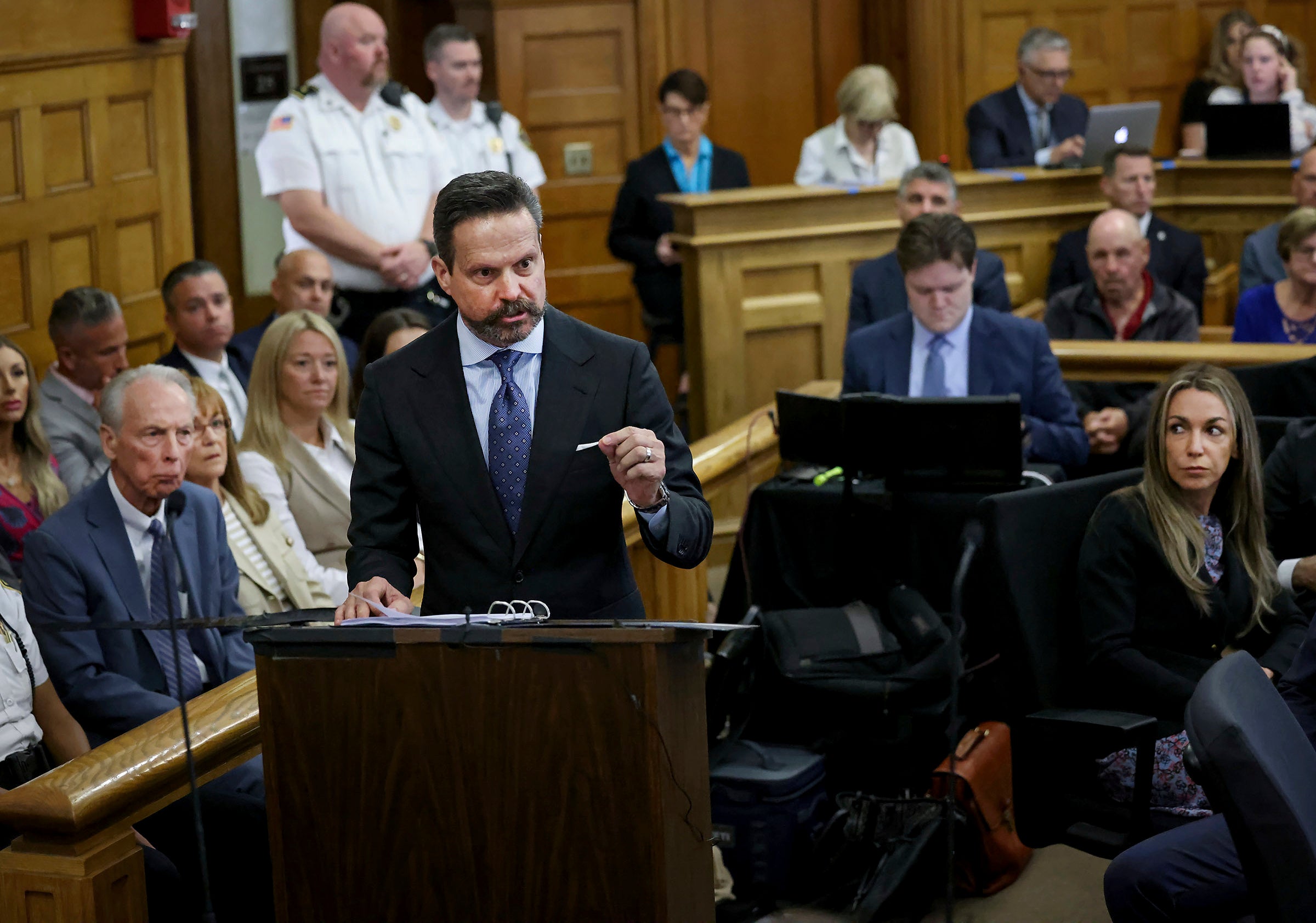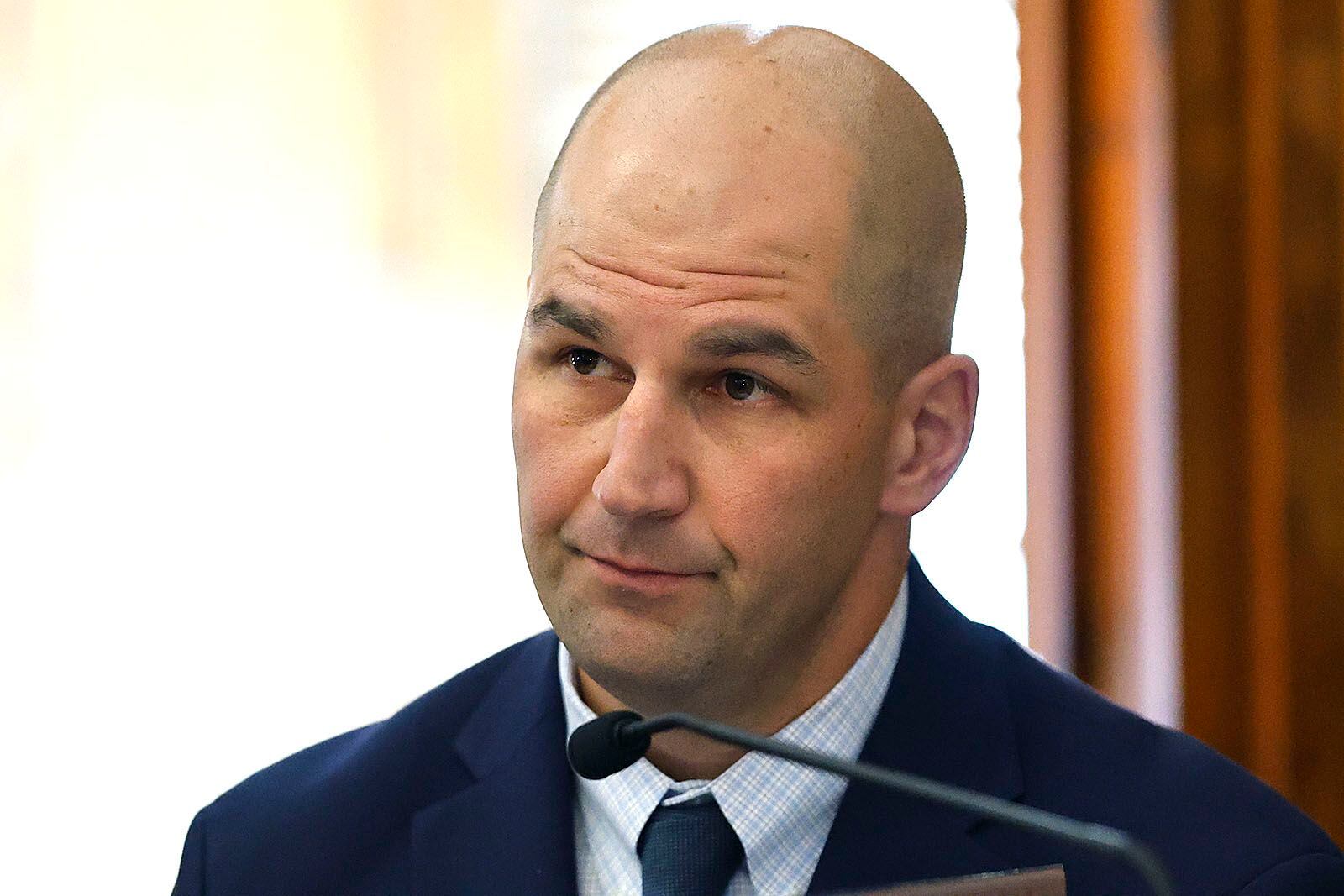Crime
Read’s fate is in the jury’s hands following closing arguments Friday.

Offering their closing arguments Friday, lawyers in the Karen Read murder retrial hammered at the evidence, clashed over allegations of corruption and bias, and supplied diametrically opposed theories of what befell John O’Keefe on a snowy night in Canton three years ago.
Up at bat for Read’s team, defense attorney Alan Jackson wove a story of a “radioactive” lead investigator who purportedly ignored another viable suspect and pinned the blame on Read early on with “zero investigation.” According to Jackson, prosecutors cannot and would not prove beyond a reasonable doubt that O’Keefe, a Boston police officer, was wounded in a collision.
“Their investigation was flawed from the start, because their investigator was corrupted from the start, by bias and personal loyalties,” he added.
Jackson picked his way through the prosecution’s key evidence, dismantling and debunking as he went. He reminded the 18 jurors they are the last line of defense “between an innocent woman and a system that has tried to break her.”
But special prosecutor Hank Brennan accused Read’s defense of trying to muddle the data with conjecture and baseless allegations.
“Don’t look the other way,” Brennan urged, borrowing a phrase from Jackson’s closing argument during Read’s first trial last summer. “Look at the facts.”
Prosecutors allege Read, 45, was driving drunk after a night of bar-hopping and deliberately reversed her SUV toward O’Keefe as she dropped him off at an afterparty in Canton early on Jan. 29, 2022. Read’s lawyers say she was framed, suggesting O’Keefe was actually beaten inside the home and attacked by the homeowner’s dog.
What Karen Read’s team said
Launching into his remarks, Jackson repeated a simple phrase from his opening statement: “There was no collision. There was no collision. There was no collision.”
He alleged prosecutors’ case against Read was corrupted from the start, overrun by conflicts, biases, and personal loyalties.
“And most fatally, it was corrupted by a lead investigator whose misconduct infected every single part of this case, from the top to the bottom,” Jackson said, taking aim at former Massachusetts State Police Trooper Michael Proctor.
The home where O’Keefe was found unresponsive in the snow was owned at the time by now-retired Boston Police Sgt. Detective Brian Albert — a fact Jackson claimed weighed heavily on Proctor’s investigation.
He suggested “the lengths to which some … police officers will go to protect their own at the expense of the rest of us” is “something that should sadden us. Something that maybe would anger us.”
Spotlight on Brian Higgins
Jackson walked jurors through O’Keefe’s final hours, noting testimony that O’Keefe and Read were loving and affectionate as they drank with friends and acquaintances the evening of Jan. 28, 2022.
He also planted seeds of doubt about Brian Higgins, one of the men present that night at the Waterfall Bar & Grille. Higgins had flirted over text with Read during her relationship with O’Keefe, and “we know that he had a romantic design on Karen,” Jackson alleged.
He played bar surveillance video that he said showed Higgins “sparring” with Albert at the Waterfall and also looking on as O’Keefe gave Read a peck on the forehead.
“This is what Michael Proctor and his investigation completely ignored,” Jackson argued. He claimed Higgins appeared “agitated,” suggesting another man at the bar grabbed Higgins’s arm in a possible attempt to “calm him down.”
“But Brian Higgins is having none of it,” Jackson continued. “He appears to be hyperfocused on one person, and one person only: John O’Keefe.”
As their time at the bar wound down, Albert issued an open invitation to continue the party back at 34 Fairview Road. Read and O’Keefe left the Waterfall together, though fellow afterparty guest Jennifer McCabe — Albert’s sister-in-law — testified the couple never made it inside.

Jackson suggested otherwise, alleging O’Keefe’s phone data showed him alive and walking after he was purportedly struck by Read’s SUV. He further criticized police for failing to secure the crime scene or search inside 34 Fairview Road, alleging investigators would have “torn that house apart” if it hadn’t belonged to another officer.
“What happened inside that house? Or that basement? Or that garage?” he wondered. “What evidence was there for the investigators to look into? What did they ignore?”
What does the defense think happened?
According to Jackson, Read drove home angrily after O’Keefe went inside 34 Fairview Road to scope out the afterparty and failed to return. Her phone connected to O’Keefe’s Wi-Fi at 12:36 a.m., and she left her boyfriend a series of increasingly enraged voicemails as she tried to get ahold of him.
“But Karen did not know what you know,” Jackson said. “She didn’t know what the investigators should have known. She didn’t know what was happening with Higgins and Albert and with her boyfriend, John O’Keefe.”
When O’Keefe still hadn’t returned later that morning, Read set out to search for him and found his “beaten, battered, bloody” body in the snow outside 34 Fairview Road, Jackson said.
Rather than a collision with Read’s SUV, he suggested O’Keefe’s injuries came from a fall backward due to a punch. A trail of abrasions on O’Keefe’s right arm were from an “obvious” dog attack, Jackson alleged, noting the Alberts owned a German shepherd at the time.
He cited the lack of bruising or broken bones on O’Keefe from the neck down as he sought to undermine prosecutors’ claim of a collision. He also pointed to medical examiner Dr. Irini Scordi-Bello’s testimony that she saw no evidence of an “impact site.”
Jackson further contrasted prosecution accident reconstructionist Judson Welcher’s “paint transfer” experiment with the testing from defense experts with ARCCA Inc. ARCCA, he said, conducted “actual testing, not some ridiculous blue paint kindergarten project” and found O’Keefe’s injuries and the damage to Read’s taillight were inconsistent.
He questioned why there was no skin or blood found on the taillight shards recovered outside 34 Fairview Road if they had, in fact, cut into O’Keefe’s arm.
‘Michael Proctor clearly is radioactive’
Returning his attention to Proctor, Jackson urged jurors to read the ex-trooper’s crass texts about Read and the investigation into O’Keefe’s death. He noted Proctor’s response to a friend’s text suggesting Albert would “receive some s***” after O’Keefe turned up dead on his front lawn.
“Nope,” Proctor replied. “Homeowner is a Boston cop, too.”
Jackson also pointed out Proctor was already predicting “serious charges” for Read and calling her a “whack job c***” during the early stages of his investigation. State Police fired Proctor earlier this year in light of his conduct during Read’s case, and neither the prosecution nor defense called the ex-trooper to testify.
“If the Massachusetts State Police can’t trust him, how can you trust him with this investigation, and with your verdict, and with Karen Read’s life?” Jackson demanded. “Michael Proctor clearly is radioactive. And the commonwealth stayed away from him.”

And while a State Police forensic scientist testified the debris from O’Keefe’s clothing contained small pieces of red and clear plastic consistent with Read’s taillight, Jackson noted Proctor had the clothing and taillight shards in his custody for a time.
“Reasonable doubt abounds,” he alleged, later adding, “Find Karen Read not guilty, not guilty, not guilty.”
What the prosecution said
In his own closing argument, Brennan painted a vivid picture of O’Keefe as he was in life: someone kind, generous, thoughtful, and dedicated to helping others.
“When his niece and nephew had nobody, he took them in,” Brennan said. “And on Jan. 29, 2022, John O’Keefe needed some help.”
“There was only one person on this planet who could help him that morning, to give him a chance,” Brennan continued. “And that one person who could help him that morning was this defendant right here, Karen Read.”
But instead of calling 911 or knocking on a neighbor’s door, he said, Read simply drove away.
“She was drunk,” Brennan alleged. “She hit him, and she left him to die.”
He pointed to the couple’s “crumbling” relationship as a possible motive, suggesting Read’s texts with O’Keefe from Jan. 28, 2022, showed an unstable relationship with tensions roiling just under the surface. Brennan also maintained Higgins was friendly with O’Keefe, even if Higgins’s flirtation with Read was not “honorable.”
Brennan walked jurors through the state’s evidence against Read, including the retrograde analysis that purportedly put her blood alcohol level between 0.14% and 0.28% at 12:45 a.m. on the 29th.
Read was “far beyond the legal limit” to drive, Brennan alleged, pushing back on Jackson’s suggestion that Read could have had more to drink after arriving back at O’Keefe’s house that morning. He played a clip from a media interview Read gave, in which she recalled drinking vodka tonics the evening of the 28th and acknowledged she “shouldn’t have been driving.”
Prosecutor: Read struck O’Keefe in a drunken rage
As Brennan noted, first responders testified Read told them her last conversation with O’Keefe was an argument. The special prosecutor suggested the “trigger” for that argument had been McCabe’s directions to the afterparty, as McCabe mentioned 34 Fairview Road was near the home of a woman O’Keefe had previously dated.
As O’Keefe got out of the car following the argument, Read “could have driven home,” Brennan asserted. “She could have broken up with him. They could have talked about it the next day.”
Instead, he alleged, Read slammed her car into reverse and stepped on the gas pedal.
Brennan explained prosecutors aren’t trying to prove that Read intended to kill O’Keefe, or even that she meant to hit him. Rather, he said, prosecutors wanted to prove Read intended to put the car in reverse and accelerate toward O’Keefe.
The data from Read’s SUV “tells a story that can’t be changed,” Brennan said, alleging Read left O’Keefe — and pieces of her taillight — scattered in front of 34 Fairview Road as she drove away.

‘She’s facing the reality of what she had done’
And while Read called O’Keefe’s phone more than 50 times that morning, Brennan reminded jurors she never called 911. He noted it took Read 28 minutes from the time she left O’Keefe’s house to search for him until she arrived at McCabe’s home to ask for help — normally a 10-minute drive.
Read was “panicked, frantic, out of her mind screaming” when she arrived at McCabe’s house the morning of the 29th, according to Brennan. “What is causing this extraordinary duress? Did she stop somewhere on the way by? Did she just see death?”
He pointed back to McCabe’s testimony that Read was the first to spot O’Keefe’s body as they pulled up to 34 Fairview Road, and that Read later told first responders, “I hit him, I hit him, I hit him.”
“[Read] is now coming to terms with the moment. Her fear is realized,” Brennan offered. “Now she’s facing the reality of what she had done.”
He accused Read’s lawyers of branding witnesses who offered adverse or inconvenient testimony liars, perjurers, or conspirators. That includes McCabe, who told jurors she made her now-infamous “hos long to die in cold” Google search at Read’s insistence after they found O’Keefe, even as the defense alleged she did so hours earlier.
According to Brennan, McCabe was concerned about O’Keefe, her longtime friend, and just wanted to help that morning.
“And what happens to her after?” he asked. “She gets vilified as a murderer. A soccer mom who came to help.”
Brennan fights back on allegations about Proctor
Addressing the proverbial elephant in the room, Brennan acknowledged Proctor’s firing but argued the ex-trooper’s actions, while dishonorable, don’t undermine the investigation’s integrity.
“We don’t need Trooper Proctor to prove this case beyond a reasonable doubt,” Brennan added, pushing back on allegations of evidence tampering.
Read’s lawyers have suggested her taillight was further damaged while in police custody and parts of its plastic cover planted outside 34 Fairview Road after the fact. However, Brennan noted the light already appeared to be missing most of its cover when captured on footage in O’Keefe’s driveway at 5:07 a.m. and 8:23 a.m. on the 29th.
“There’s no boogeyman,” he maintained. “There’s no plant. There’s no Higgins at the sallyport. There’s no one tearing out pieces.”
Read, he said, left O’Keefe alone to die.
“John O’Keefe was a person, and he was murdered by Karen Read,” Brennan concluded.

What’s next?
Following a short lunch break, Judge Beverly Cannone walked jurors through a laundry list of instructions and criteria for each charge and sent them into deliberations after the clerk picked six alternates.
Read has pleaded not guilty to charges of second-degree murder, manslaughter while operating a motor vehicle under the influence, and leaving the scene of a fatal collision. She remains free on bail.
There are several possible outcomes as deliberations get underway, and any conviction or acquittal must be unanimous.
Sign up for the Today newsletter
Get everything you need to know to start your day, delivered right to your inbox every morning.

